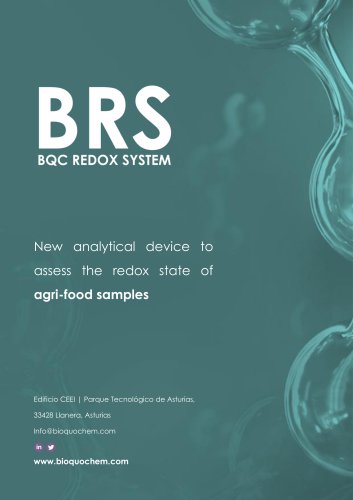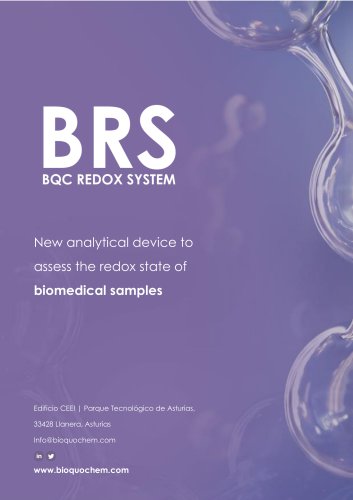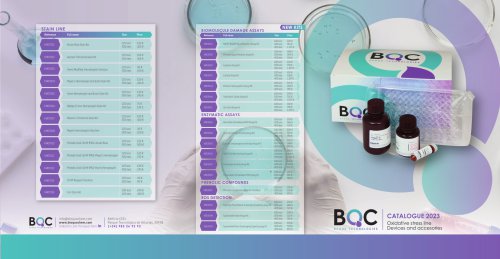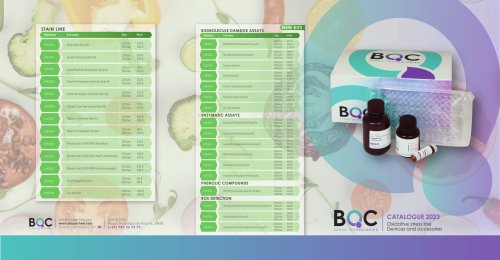 Website:
Bioquochem
Website:
Bioquochem
Catalog excerpts

New analytical device to assess the redox state of agri-food samples Edificio CEEI | Parque Tecnológico de Asturias, 33428 Llanera, Asturias Info@bioquochem.com www.bioquochem.com www.bioquochem.com Bioquochem S.L.
Open the catalog to page 1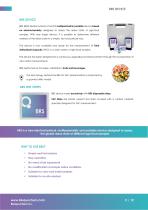
BRS DEVICE BRS (BQC Redox System) is the first multiparametric portable device based on electrochemistry designed to assess the redox state of agri-food samples. With one single device, it is possible to determine different markers of the redox state in a simple, fast and precise way. The device is now available and ready for the measurement of Total Antioxidant Capacity (TAC) in a wide variety of agri-food samples. The device has been designed for a continuous upgrading and improvement through the incorporation of new redox measurements. BRS performance has been validated in fruits and...
Open the catalog to page 3
BRS DEVICE HOW TO USE BRS DEVICE The use of the BRS device is very simple. Just insert the test strip into the device, mix the sample with the BRS Electrolyte, place a drop of sample onto the test strip, and start the measurement. The device is controlled by a specially designed App to use on your mobile device. BRS App functions include running the measurements and storing and sharing the data. In approximatly 1 min results are displayed on your mobile device. Click the button to turn on the BRS Pair your mobile with the BRS device using Bluetooth Mix the sample with BRS Electrolyte Insert...
Open the catalog to page 4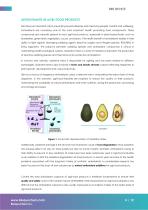
BRS DEVICE ANTIOXIDANTS IN AGRI-FOOD PRODUCTS Diet plays an important role in preventing several diseases and improving people´s health and wellbeing. Antioxidants are nowadays one of the most important health promoting food components. These compounds are naturally present in most agri-food products, especially in plant-based foods, such as blueberries, green leafy vegetables, cocoa, and beans. The health benefit of antioxidants resides in their ability to fight against damaging oxidizing agents (reactive oxygen and nitrogen species, ROS/RNS) in living organisms. The balance between...
Open the catalog to page 5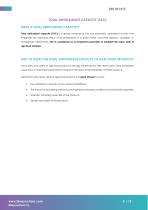
TOTAL ANTIOXIDANT CAPACITY (TAC) WHAT IS TOTAL ANTIOXIDANT CAPACITY? Total antioxidant capacity (TAC) is a global measure of the non-enzymatic antioxidant activity that integrates the individual effect of all antioxidants in a given matrix, and their additive, synergistic or antagonistic interactions. TAC is considered as an important parameter to establish the redox state of agri-food samples. WHY TO ASSAY THE TOTAL ANTIOXIDANT CAPACITY OF AGRI-FOOD PRODUCTS? The quality and safety of agri-food products is strongly influenced by their redox state. Total antioxidant capacity is an important...
Open the catalog to page 6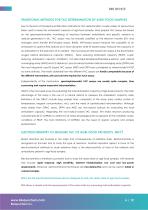
BRS DEVICE TRADITIONAL METHODS FOR TAC DETERMINATION OF AGRI-FOOD SAMPLES Due to the lack of standard quantification methods for TAC determination a wide variety of assays have been used to assess the antioxidant capacity of agri-food samples. Most popular TAC assays are based on the spectrophotometric monitoring of reactions between antioxidants and specific oxidants or radicals generated in situ. TAC assays may be broadly classified as the electron transfer (ET)- and hydrogen atom transfer (HAT)-based assays. Briefly, HAT-based assays measure the capability of an antioxidant to quench...
Open the catalog to page 7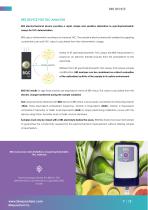
BRS DEVICE BRS DEVICE FOR TAC ANALYSIS BRS electrochemical device provides a rapid, simple and sensitive alternative to spectrophotometric assays for TAC determination. BRS uses a voltammetric technique to measure TAC. The sample is electrochemically oxidized by applying a potential scan and TAC value is calculated from the voltammetric charge. Similar to ET spectrophotometric TAC assays the BRS measurement is based on an electron transfer process from the antioxidants to the electrode. Different from ET spectrophotometric TAC assays that require sample modification, BRS analyses can be...
Open the catalog to page 8
Table 1. Comparison of methods for TAC determination. BRS ANALYTICAL CHARACTERISTICS FOR TAC ANALYSIS LINEAR RANGE BRS exhibits a wide linear range for the most used standards of TAC. All the standards were prepared in BRS Electrolyte. Thanks to this wide linear range no sample dilution is required for the analysis of most of the samples. The wide linear range of BRS Device minimizes sample dilution. Table 2. BRS linear range for TAC standards. *Linear range for TROLOX spectrophotometric detection (BQC Assay Kits): ORAC, 10-175 ^M ABTS, 50-600 ^M DPPH, 100-500 ^M CUPRAC, 250-2000 ^M
Open the catalog to page 9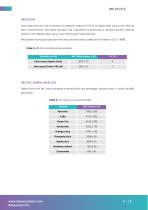
Intra-assay precision was evaluated by replicate analysis (n=10) of an apple juice using a new strip for each measurement. Inter-assay precision was calculated by measuring a standard solution (100 |jM Trolox) on ten different days using a new strip for each measurement. BRS analysis shows good precision with intra and inter-assay coefficients of variation (CV) < 10 %. Table 3. BRS intra and inter-assay precision.
Open the catalog to page 10
Edificio CEEI | Parque Tecnológico de Asturias, 33428 Asturias, Spain info@bioquochem.com www.bioquochem.com linkedin.com/bioquochem
Open the catalog to page 11All Bioquochem catalogs and technical brochures
Archived catalogs
-
PRODUCT CATALOGUE 2018
32 Pages
-
STAIN LINE CATALOGUE
16 Pages

